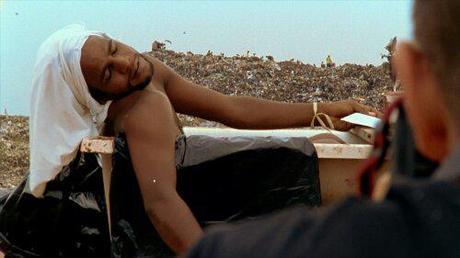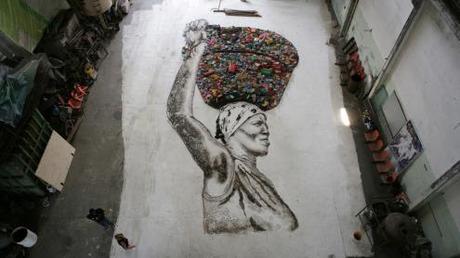Now I come to the close of my month long documentary posts. I had to think about what would be a good documentary to close out this little venture, thinking I needed a grand opus of a film to make my closing mark. I could have gone many ways with this post, choosing something provocative or entertaining. I decided to continue with the theme of art, mainly because I enjoy my previous post on “Exit Through The Gift Shop”, which was an entertaining look at the street art world through the lens of hype and commercialism.
Today I chose Waste Land, a documentary that marries a beautiful style of art and humanity. It is one of the more emotionally challenging films, viewing art through those that inspire the artist and how a piece of them makes its way into the work. Portraits made of rubbish, all made to look like the people who work with the garbage everyday and there is a story and face behind each work.

Vik Muniz is an artist who literally creates treasure out of trash; using cast-offs he finds at garbage dumps, Muniz fashions re-creations of famous paintings, and he made an evocative series of images of children who work in sugar plantations using the leftovers from the refining process. So when filmmaker Lucy Walker asked Muniz if she could make a film about him as he worked on his next project, the two settled on what seemed like the perfect location — Jardim Gramacho, a Brazilian landfill not far from Rio de Janeiro that’s said to be the largest refuse dump in the world. Walker‘s documentary Waste Land explores Muniz‘s creative process as he fashions new works from what others have left behind, but it also profiles the people who live near Jardim Gramacho and make their living by sorting what’s useful from what is not. Walker lends a dignity to these so-called “trash pickers” as they reveal how much of value can be found in other people’s refuse and how they maintain their pride and self-respect despite their sometimes meager circumstances. ~ Mark Deming, Rovi
Waste Land is both visually and narratively powerful. A touching look at the trash pickers in the Jardim Gramacho, Vik Muniz creates a beautiful portrait of the people who are considered trash themselves by society. Leftovers from a life they no longer had, they wade through the garbage of the country, making a living off the discarded excess of society. While a social look at their plight and conditions, the documentary is an artistic piece with Muniz picking a select few to take part in a process that is foreign to them.
In some instances, there has to be a muse to spark the artistic endeavor, Muniz made his life using the trash and garbage of society to turn what is undesirable or useless into art and desirable. I was never familiar with his work, so going into the film cold turkey was a relief as I learn to grow and appreciate what he does, instead of coming into the film with an established critique. What unfolded was a touching look at how he approaches the subject of art and his inspiration. Utilizing workers from the landfill, we understand their stories, why they are there, and what makes them unique as they all have a different story to tell. Muniz begins to shape the images and art into their images, reflecting their lives and ultimately changing the garbage and their lives into a thing of beauty. To see the workers have a hand in the process of Muniz’ work is a thing of beauty.

On the outset, Waste Land is more about the lives of the workers in the landfill than it is about Muniz and his ambitious art goal. He has made his life making art from the thrown away excess of life and to use the people who handle that excess, but live a life of no excess, is a nice contrast to his art. His subjects, the workers of the landfill, all comes from some hardship that leads them to a job where they are underpaid and have no visible future. Only the dreams of making it out of there and moving on from their lives keeps their spirits high as they sift through the rubbish of society. The end product, the art that is created by them and Muniz, is as beautiful as the subjects themselves.
I don’t want to go on and on about the documentary, as there is a lot of story to dive into with the people Muniz chooses for his art and how their lives are shaped before and after the experience. It is a touching documentary that exhibits a sort of emotional connection that is missing from most art documentaries. It is always about the artist and his endeavors, not the artists and the subjects. Their stories and lives make the art, not the artist. You are in luck that the film is streaming on Netflix, so there should be no reason you can give to not see this film.
*images via Official Site
Advertisement
